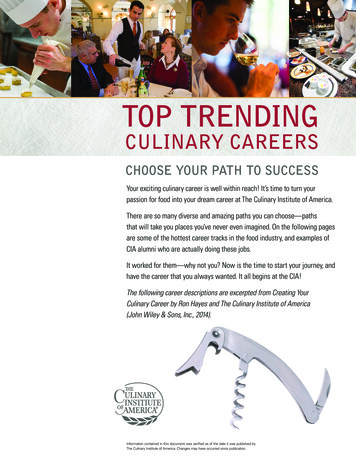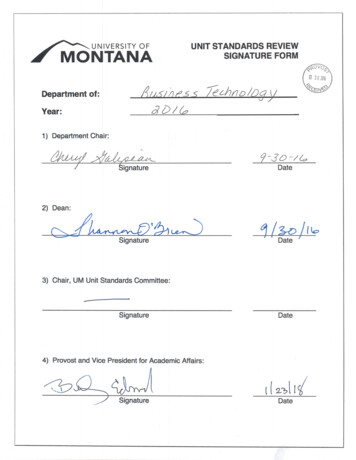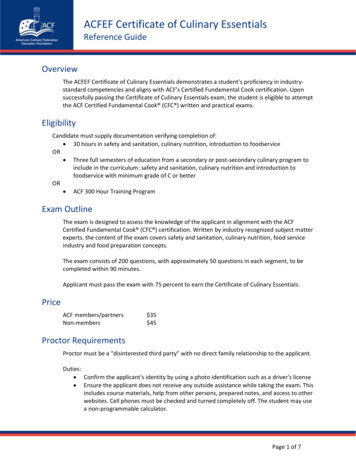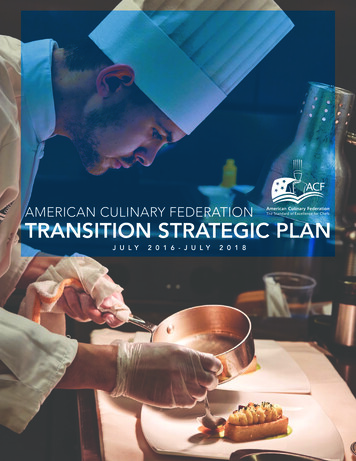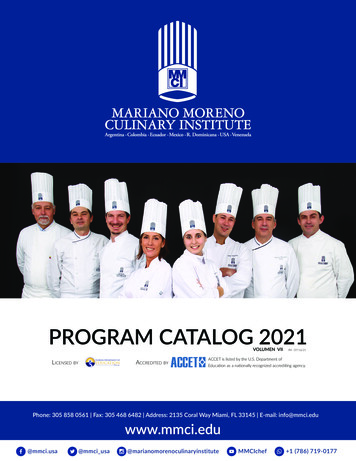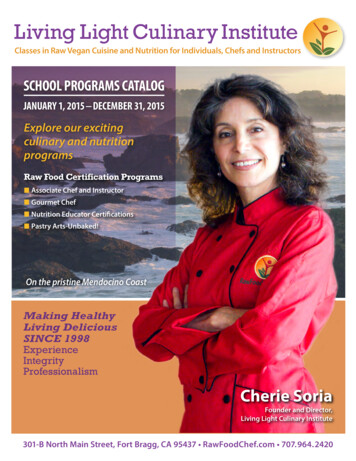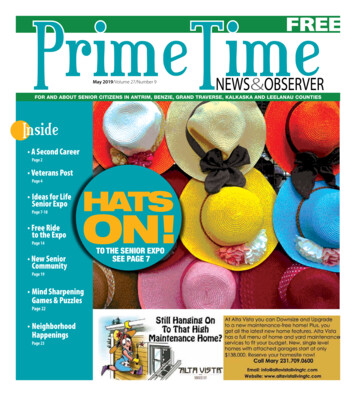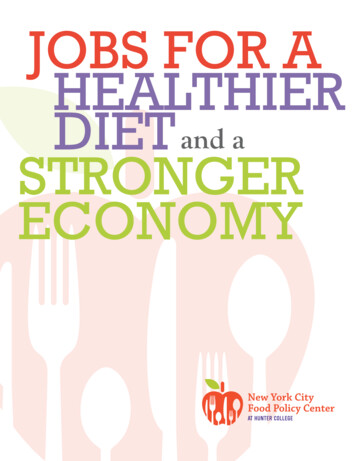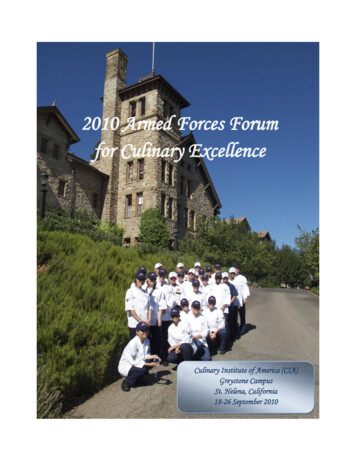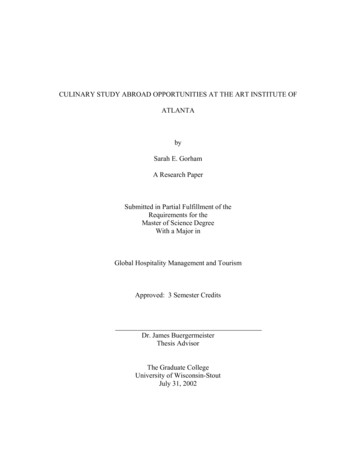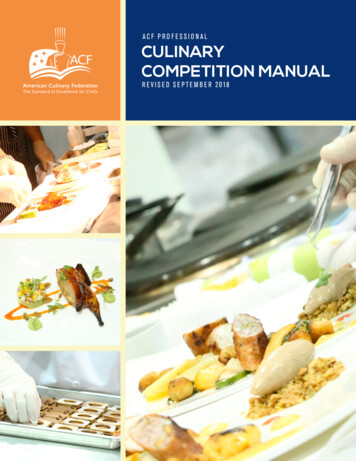
Transcription
ACF PROFESSIONALCulinaryCompetition ManualR e v ise d S ep t e m b er 2 0 18
Table of contentsC h a pt er I. pg 3C h a pt er 5 . pgs 37-43Goals, Organization and ObjectivesCompetition Scoring and CritiquesC h a pt er 2 . pgs 4-25Traditional Competition Categories (Professional)yy Category A Cookingyy Scoring and Assessments for all categoriesC h a pt er 6 . pg 44Awardsyy Category B Cookingyy Culinary Competition Medalsyy Category C Patisserie/Confectioneryyy Certificates of Participationyy Category D Showpieceyy Medal Policyyy Category E Live-Action Showpiecesyy Category F Hot Food Mystery Basketsyy Category G Edible Cold Foodyy Category H Ice CarvingC h a pt er 7. pgs 45-49ACF-Certified Culinary Judge Programyy Application for ACF-Certified Culinary JudgeC h a pt er 3. pgs 26-31Contemporary Competition Categories (Professional)yy Category KC – Contemporary Hot Foodyy Category KP – Contemporary Patisserieyy Category KG – Green, Sustainable and Local FoodCookingyy Category W – Customized Wildcardyy Apprentice Judge CritiqueChapter 7iscurrentlybeingupdatedAppendix . pgs 50-73yy Culinary Competition Applicationyy Judge’s Letter of Commitmentyy Show Chair Competition Checklistyy Waiver of Liability–Ice Carvingyy Competition Agreement FormC h a pt er 4 . pgs 32-36Competition Organizationyy Competitor/Coach Critique of Judgesyy Show Chair Evaluationyy Lead Judge Evaluationyy Score Sheetsyy Judge’s Summary Score Sheet 2018, A mer ican Culinar y F eder a t ion, Inc. A ll r igh t s r eser ved. No par t of t his documen t may bedisclosed or r epr oduced in any for m wi t hou t ex pr ess wr i t ten consen t of t he A mer ican Culinar y F eder a t ion.2
Chapter 1G oals , organi z a t ion & o b j ec t i v esGoals of ACF Certified Culinary CompetitionsPrimaryyy To continually raise the standards of culinary excellence and professionalismyy Nurture the creativity of individual chefsyy Provide a showcase for individual skills, techniques and stylesyy Provide a means of earning ACF certification pointsSecondaryyy Provide an arena to demonstrate the mutual link between taste and healthyy Provide an example and inspiration for young professionalsThese goals are accomplished by:Primaryyy Maintaining established culinary standardsyy Promoting camaraderie and educational opportunities among culinary professionalsyy Acting as a staging area for development of culinary conceptsSecondaryyy Fostering the development of cutting-edge presentationsyy Nurturing future leaders of culinary, baking and pastryyy Providing rewards of recognitionPurpose of the Culinary Competition Manualyy To ensure a nationwide, uniform standard and criteria for the judging of culinary competitionsyy To clearly present the criteria for all categories of culinary, baking and pastry competitionyy To provide general competition guidelines for competitors and judgesACF Pr ofessional Compe t i t ion Manual Revised Sep tember 20183
Chapter 2Tra d i t ional co m pe t i t ion ca t egoriesCategory A — Cooking, Professional, Individualyy Competitors are required to display their choice of one of Category A.yy All displays must have a menu and description of the platter, hours d’ oeuvres, or finger foods, without a name or property affiliation.A-1Cold buffet platter of meat, beef, veal, lamb or porkA-2Cold buffet platter of fish and/or shellfishA-3Cold buffet platter of poultryA-4Cold buffet platter of game Cold buffet platters need to be a minimum of eight portions on the platter and one portion on a display plate. The competitor must demonstrate at least three protein items, three garnishes, one salad (served on the side) and at least oneappropriate sauce and one condiment, relish, etc. In addition, the end piece of each protein must be displayed on the platter.A-5Four varieties of cold hors d’oeuvres with six portions of each, served with appropriate sauces and garnishes and one presentationplate containing 1 piece of each variety and related accompanimentsA-6Four varieties of finger foods with six portions of each, two hot and two cold varieties all presented cold and one presentation platecontaining 1 piece of each variety and related accompaniments. Finger Foods must weigh between 10 to 20 grams each and shouldbe able to be eaten in one bite.Gener al Guidelines for Category AThe following list provides a good beginning checklist of what is considered general guidelines for both competitors who aredeveloping displays and judges who will evaluate them.yy Ingredients and garnishes should harmonize with the main part of the dish and conform to contemporary standards ofnutritional values.yy Unnecessary ingredients should be avoided, and practical, acceptable cooking methods should be applied.yy Finger Foods may be served on porcelain, glass, cup fork or spear. They can be accompanied by a sauce and small garnish.They should not require any additional cutlery to be eaten. In addition, they should be practical to pick-up, take and eat.yy All items should display a variety of techniques, designs and shapes and should be visually appetizing.yy On buffet platters, garnishes are not to be mistaken with finger foods. No bowls, spears or small plates are allowed onbuffet platters.yy Bread and butter are not judged on buffet platters.yy Platters must also be innovative, colorful and have harmonious flavorsyy Competitors are encouraged to use a variety of cooking methods and ingredients.yy Use correct cooking, presentation, color and flavor combination.yy Dressing the rims of the plates results in an unacceptable appearance.ACF Pr ofessional Compe t i t ion Manual Revised Sep tember 20184
yy Meat should be carved properly and cleanly.yy Meat slices should be served with the carved surface upwards and arranged in order and size.yy Numerical harmonizing of meat portions and garnishes is required.yy Fruits and vegetables must be cut or turned uniformly.yy Binding agents may be used for creams.yy The amount of gelatin used in aspics may exceed normal quantities, but not to the extent that the style of presentation isdependent on the extra gelatin content.yy Avoid all non-edible items.yy Food prepared hot, but displayed cold, should not be served on a chemise plate or platter.yy Dishes prepared hot, but displayed cold, should be glazed with aspic.yy Sauce boats should reflect the correct amount needed for the platter.yy Aspic used should refer to the product.yy Glazing work should be clean and free of defects.yy Use practical portion size. In general, portion weight should be in keeping with the norms of accepted practice andnutritional balance.yy Demonstrate clean, crisp workmanship.yy No identification of personal or business affiliation is allowed with the exhibits until the judging is completed.yy The punctual presentation of each exhibit at the appointed time is urgent.yy Although table decorations and lighting are not part of the actual judging, a well presented and attractive table will add to thehigh-quality image that the competitor attempts to project.Category B — Cooking, Professional, Individualyy Competitors are required to display their choice of one of Category B.yy All displays must have a description or menu of all items displayed without any name or property affiliations.B-1Three different cold appetizer platesB-2Three different hot appetizer plates, presented coldB-3One five-course menu gastronomique for one person, prepared hot and presented cold, comprising of two appetizers, oneconsommé, one salad and one entree, OR one appetizer, one consommé, one salad, one entree and one dessert, all with properportions and contemporary presentationsB-4One lacto-ovo vegetarian four course menu for one including a dessertGener al Guidelines for Category BThe following list provides a good beginning checklist of what is considered general guidelines for both competitors who aredeveloping displays and the judges who will evaluate them.yy Ingredients and garnishes should harmonize with the main part of the dish and conform to contemporary standards ofnutritional values.ACF Pr ofessional Compe t i t ion Manual Revised Sep tember 20185
yy Unnecessary ingredients should be avoided, and practical, acceptable cooking methods should be applied.yy Competitors are encouraged to use a variety of cooking methods and ingredients.yy Use correct cooking, presentation, color and flavor combination.yy Dressing the rims of plates results in an unacceptable appearance.yy Meat should be carved properly and cleanly.yy Meat slices should be served with the carved surface upwards and arranged in order and size.yy Fruits and vegetables must be cut or turned uniformly.yy Binding agents may be used for creams.yy The amount of gelatin used in aspics may exceed normal quantities, but not to the extent that the style of presentation isdependent on the extra gelatin content.yy Avoid all non-edible items.yy Food prepared hot, but displayed cold, should not be served on a chemise plate or platter.yy Dishes prepared hot, but displayed cold, should be glazed with aspic.yy Sauce boats should reflect the correct amount or portion for the item it is accompanying.yy Aspic used should refer to the product.yy Glazing work should be clean and free of defects.yy Use practical portion size. In general, portion weight should be in keeping with the norms of accepted practice andnutritional balance.yy Demonstrate clean, crisp workmanship.yy No identification of personal or business affiliation is allowed with the exhibits until the judging is completed.yy The punctual presentation of each exhibit at the appointed time is urgent.yy Although table decorations and lighting are not part of the actual judging, a well presented and attractive table will add to thehigh-quality image that the competitor attempts to project.Category C — Patisserie/Confectionery, Professional, Individualyy All Competitors are required to display their choice of one of Category C.yy All displays must have a description or menu of all items displayed without any name or property affiliations.C-1One buffet platter of fancy cookies, chocolates, or petit fours. Five varieties, six portions of each and one presentation plate with one of each variety for the judges inspection Individual weight of each to be 6-14 grams.C-2Six different individual hot or cold plated desserts Each plate must be prepared as an individual plated serving. All displayed cold.ACF Pr ofessional Compe t i t ion Manual Revised Sep tember 20186
C-3Decorated or sculpted celebration cake Minimum of one tier Choice of medium such as sugar paste, rolled fondant, royal icing, chocolate, marzipan, buttercream and sugar Minimum of three techniques displayed Minimal use of non-edible materials can be used to support tiers internally. A limited amount of wires can be used for gum paste flowers. Can be any shape with a maximum display area of 15” x 15” No dummy cakes are permitted.C-4Wedding cake Minimum of three tiers with a maximum display area of 36” x 36” Choice of medium such as sugar paste, rolled fondant, royal icing, chocolate, marzipan, buttercream and sugar Non-edible materials can be used to support each tier and a limited amount of wires can be used for gum paste flowers. No dummy cakes are permitted.C-5Assorted bread display Three different types of dough with two products from each dough type for a total of six different items Items should be freshly baked without any spray lacquer. Please have one of each product sliced or cut in half for the Judge’s inspection. Dough choices Laminated Dough-Danish, Croissant, etc. Lean Dough-French Bread, Italian Bread, Sourdough, Hard Roll, etc. Rich Dough-Challah, Brioche, Stollen, Kugelhopf, etc. Soft Dough- Parker House, Clover Leaf, Mixed Grain, etc. Quick Bread-Muffin, Biscuit, Scones, etc. Product Requirements-One product is considered as: One dozen of rolls or individual items such as dinner rolls, croissant, muffins Danish, or etc. Two loafs or two each of the same item such as baguette, country loaf, Stollen, Kugelhopf, or etc.Gener al Guidelines for Category CThe following list provides a good beginning checklist of what is considered general guidelines for both competitors who aredeveloping displays and the judges who will evaluate them.yy Ingredients and garnishes should harmonize.yy Unnecessary ingredients should be avoided and practical, acceptable cooking methods should be applied.yy Proper techniques and accepted methods of preparation should be adhered to throughout the display.yy Competitors are encouraged to use a variety of cooking methods and ingredients.yy Use correct cooking, presentation and flavor combination.yy Dressing the rims of plates results in an unacceptable appearance.ACF Pr ofessional Compe t i t ion Manual Revised Sep tember 20187
yy Fruits and vegetables must be cut or turned uniformly.yy Binding agents may be used for creams.yy The amount of gelatin used in items may exceed normal quantities, but not to the extent that the style of presentation isdependent on the extra gelatin content.yy Avoid all non-edible items.yy Glazing work should be clean and free of defects.yy Use practical portion size. In general, portion weight should be in keeping with the norms of accepted practice andnutritional balance.yy Demonstrate clean, crisp workmanship.yy Numerical harmonizing of dessert portions, garnishes and accompaniments is required.yy Properly bake dough or crusts.yy Display proper thickness for various crusts and cookiesyy Cleanly apply icings and glazes of the correct thickness and proper shine.yy All chocolate work should be properly tempered and the correct thickness.yy All piping work should be thin, delicate and show accurate workmanship.yy Coloring used should be appropriate and not excessive.yy No identification of personal or business affiliation is allowed with the exhibits until the judging is completed.yy The punctual presentation of each exhibit at the appointed time is urgent.yy Although table decorations and lighting are not part of the actual judging, a well presented and attractive table will add to thehigh-quality image that the competitor attempts to project.Category D — Showpieces, Professional, Individualyy Exhibits in this category should demonstrate the difference between cookery and culinary arts.yy Showpieces are eligible to be entered in only one ACF competition.Choice of the following mediums:D-1Vegetable/Fruit Base may not exceed 30” x 30.” No height restrictions Basic internal structures may be used. The minimal use of tooth picks and skewers are allowed. Do not use any non-edible floral items or foliage. Demonstrate a variety of techniques.D -2Tallow and Saltillage Base may not exceed 30” x 30.” No height restrictions Basic internal structures may be used. Demonstrate a variety of techniques.ACF Pr ofessional Compe t i t ion Manual Revised Sep tember 20188
D -3Bread Dough Base may not exceed 30” x 30.” No height restrictions The use of non-edible materials is not allowed. Edible Lacquer can be used. Demonstrate a variety of techniques.D -4Chocolate, Cooked Sugar, Pastillage, and Marzipan Base may not exceed 30” x 30.” No height restrictions Competitors may use a basic non-edible base or platter to mount or display the centerpiece on. No internal structures are allowed. The centerpiece must be 75% of the primary medium and the remaining 25% is a choice of medium including theprimary medium. Use of commercial molds is not permitted with the exception of basic geometric shapes like spheres, cubes, etc. and theuse of silicon noodles or metal bars. All chocolate work should be properly tempered and the correct thickness. Present smooth, properly-sanded pastillage work, free of visible cracks and seams. Present sugar work having the proper shine, thickness and harmonious coloring. Demonstrate a variety of techniques.Gener al Guidelines for Category DThe following list provides a good beginning checklist of what is considered general guidelines for both competitors who aredeveloping displays and the judges who will evaluate them.yy Use a variety of techniques within each medium.yy Use of commercial molds is not permitted unless otherwise noted.yy No external supports are allowed.yy Proper techniques and accepted methods of preparation should be adhered to throughout the display.yy Avoid all non-edible items unless otherwise noted.yy Demonstrate clean, crisp workmanship.yy No identification of personal or business affiliation is allowed with the exhibits until the judging is completed.yy The punctual presentation of each exhibit at the appointed time is urgent.yy Although table decorations and lighting are not part of the actual judging, a well presented and attractive table will add to thehigh-quality image that the competitor attempts to project.Category E – Live Action Showpieces, Professional, Individualyy All work must be done on-site by the competitor.yy All work must be displayed on an acceptable food surface.ACF Pr ofessional Compe t i t ion Manual Revised Sep tember 20189
E-1Fruit / Vegetable Carving Mystery Basket Theme announced in advance by show chair. Competitor has three hours to create and display showpiece. All competitors receive identical basket of fruits and vegetables. All items in mystery basket must be utilized in final showpiece. Base cannot exceed 30” x 30”, height is unrestricted. The minimal use of tooth picks and skewers is allowed. Avoid the use of non-edible floral items or foliage.E-2Cake Decorating Theme announced in advance by show chair Competitor has three hours to decorate and display cake. Cake is to be 3-tiers. Base cannot exceed 30” x 30.” Competitors may bring cakes of any shape filled and with a basic crumb coat (cake should still be visible). Cakes should not have any final finish on them. Competitors will finish the cake with their choice of glaze, buttercream, rolled fondant, chocolate, etc., and decorate itto fit the theme. Decorations cannot be brought in, only the raw materials necessary to make them (for example marzipan, chocolate,sugar, etc.). Cakes may be sliced for inspection by the judges to ensure that only edible cakes are used, however cakes will not be tasted. All decorations must be of edible materials. Non-edible materials can be used to support the tiers internally and a limited amount of wires can be used for gumpaste flowers only. Competitors may bring in an air brush.E-3Decorative Centerpiece Competitors have three hours to create a decorative centerpiece of chocolate, marzipan, pastillage, or gumpaste. The centerpiece must be 75% of the primary medium and the remaining 25% is a choice of medium including theprimary medium. Base cannot exceed 30” x 30”, height is unrestricted. Competitors may bring in a basic non-edible base or platter to mount or display the centerpiece on. A simple, generic base of, pastillage, chocolate, nougat, etc., in a simple shape, may be brought in to build the piece on. The centerpiece should be entirely made of edible materials. A limited amount of wires will be allowed for gum paste flowers. Use of commercial molds is not permitted with the exception of basic geometric shapes like spheres, cubes, etc. and theuse of silicon noodles or metal bars. Any decorating of the base must be done on-site. Chocolate can be brought in chopped or in coins.ACF Pr ofessional Compe t i t ion Manual Revised Sep tember 201810
Pastillage and gum paste can be pre-made and brought in, but must be kept white. Any coloring or assembly must be doneduring the competition. Competitors are responsible for bringing their own tools, marble slabs, sugar equipment, measuring scale, warming lampand hair dryer (for cooling). Competitors may bring in a household-size (small) microwave. Pre-warming and tempering the chocolate in the staging area is permitted.E-4Sugar Centerpiece Competitors have four hours to create a decorative sugar centerpiece. A maximum of 25% of the centerpiece can be of pastillage and/or pressed sugar. Base cannot exceed 30” x 30”, height is unrestricted. Competitors may bring in a basic non-edible base or platter to mount or display the centerpiece on. All pulling and blowing must be done on-site. Pastillage can be pre-made and brought in, but must be kept white. Any coloring and assembly must be done duringthe competition. Use of commercial molds is not permitted with the exception of basic geometric shapes like spheres, cubes, etc. and theuse of silicon noodles or metal bars. Competitors are responsible for bringing their own tools, marble slabs, sugar equipment, measuring scale, warming lampand hair dryer (for cooling). Competitors may bring in a household-size (small) microwave. Competitors can bring cooked sugar of their choice in to the kitchen ready to be poured, pulled or blown.Attention Organizersyy Decorative centerpieces may require select room temperatures.yy Use of a microwave oven in categories E-3 and E-4 is imperative, particularly to allow full and elaborate sugar work. Electricalrequirements must be evaluated before the competition and an adequate power source provided to avoid any problems.yy A kitchen is not required for category E, however each competitor must be provided with one 8 foot banquet table for working andone 6 foot banquet table for display and have access to sanitation and hand washing facilities.Gener al Guidelines for Category EThe following list provides a good beginning checklist of what is considered general guidelines for both competitors who aredeveloping displays and the judges who will evaluate them.yy Ingredients and garnishes should harmonize.yy Proper techniques and accepted methods of preparation should be adhered to throughout the display.yy Use a variety of techniques and display multiple skills.yy Avoid using non-edible items unless noted.yy Demonstrate clean, crisp workmanship.yy All chocolate work should be properly tempered and the correct thickness.yy Present sugar work having the proper shine, thickness and harmonious coloring.yy The punctual presentation of each exhibit at the appointed time is urgent.yy Although table decorations and lighting are not part of the actual judging, a well presented and attractive table will add to thehigh-quality image that the competitor attempts to project.ACF Pr ofessional Compe t i t ion Manual Revised Sep tember 201811
Category F — Hot-Food Mystery Basket Competition, ProfessionalHot-food competitions are those events in which competitors cook and present food to be judged on taste as well as execution ofskills and presentation.These competitions are somewhat larger in scope than cold-food competitions, in that kitchen space is required, raw products mustbe provided and monitored, and student helpers, proctors and servers must be provided.This is a “blind judging.” There are different judges to evaluate the kitchen and tasting.It is expected that chef competitors will dress in full professional chef’s whites, including hat, apron, scarf and kitchen towels duringthe competition.Hot-food competitions that make use of the mystery basket are the best kind in determining the skills required of chefs and cooks.Ingredients for the mystery basket will vary in each competition, but they must always be the same for each competitor in anygiven competition, and must never be revealed in advance. The mystery basket must be approved by the lead judge prior to thecompetition. The following comments will help show organizers prepare a mystery basket:yy A portion of all mystery box items must be used in the menu.yy Use of whole items with bone and utilization of bones and protein scraps is encouraged to show the fundamental skills ofthe competitors.yy In addition to the main items, there should be some salad ingredients if greens are not included in the kitchen staples.yy Items suitable for a dessert should also be included if a dessert is a required part of the menu.Procedure1. Before the competition and during the judges’ meeting, competitors will draw for starting sequence and kitchenassignments.2. Kitchen assignments should follow the starting sequence, i.e., the competitor who starts first should have kitchen #1, andso forth.3. While competitors are waiting to begin, they should be kept away from the kitchen area so they do not gain an unfairadvantage by seeing the contents of the market basket.4. Competitors may bring only their tools, i.e., knives and cutters.5. Organizers must specify the number and type of small appliances that will be allowed to be brought in by competitors.6. No substitutions for items in the basket can be made. After submitting the recipe menu, each competitor must complete theassignment within the allotted cooking time.Kitchen Station RequirementsWhile all competitors may be working in the same kitchen, each must be provided with his or her own workstation. Each stationmust include the following:yy Adequate worktableyy Four-to-six-burner stove with ovenyy Sink with running water, may be sharedyy Cutting boardsyy Access to refrigeration and freezer space, may be sharedyy Power supply, four outlets per stationyy Cubed ice, ice supplyyy Generic white china plates, various shapes and sizes (if available)yy Garbage receptaclesACF Pr ofessional Compe t i t ion Manual Revised Sep tember 201812
yy Hot and cold water sanitation station in immediate vicinityyy To maintain sanitation, brooms, mops, paper towels, plastic wrap, foil, bleach and bucketsyy Competitor is allowed to bring in an additional burner cooking unit.yy Measuring scale to be available to competitors, measuring in ounces and poundsyy Large clock in competition area for accurate timekeepingCommunity KitchenThe community kitchen should include small appliances, such as meat slicers, pasta machines, food processors and blenders thatwill be shared by all competitors. All competitors must receive an exact list of items available in the community kitchen at least twoweeks before the competition.Judges’ Station RequirementsA small room or private area should be reserved for the tasting judges with the following itemsyy Silverwareyy Napkinsyy Wateryy Clipboardsyy Notepadsyy Pencils/pensyy Calculatoryy Stapleryy A competitor staging area for check-in by the judgesyy Copies of menus from each competitor for each judgeyy Complete starting-time schedulesyy All taste and skill-based score sheets and tally sheets completed with all competitor information, prepared for the judgesyy Score keepers to assist judgesyy An apprentice/runner to clear dirty dishes, refill water and replace silverware and napkins as neededApprenticeIn the event that apprentices are made available to competitors, it is important to keep in mind that they are a student and are to beof assistance to the competitor for basic work assignments. To qualify as an apprentice the person must meet the following criteria:yy Be a current ACF Student Culinarian Memberyy Be enrolled in an accredited post-secondary program or apprenticeship programApprentices CANyy Help set up and tear down, and assist in placement of ingredients and equipmentyy Place things in the refrigerator or freezer and deliver the finished plates to the judges’ tableyy Physically open the oven and insert or remove products as instructed by the chefyy Use basic knife skills (peeling, dicing and cutting) in preparation for mise en placeyy Function as a timekeeper to enable the chef to remain on trackyy Keep the chef’s equipment washed and stored in a sanitary mannerACF Pr ofessional Compe t i t ion Manual Revised Sep tember 201813
Apprentices CANNOTyy Physically combine any of the ingredients once the mise en place stage is completedyy Finish or decorate any of the platesNote: An apprentice is not eligible to receive a competition medal for their participation.Community StoreroomThe community storeroom, from which all competitors may draw, will include, but is not limited to, the items below. All competitorsmust receive an exact list of items available in the community storeroom at least two weeks before the competition. In no caseshould items in the mystery basket duplicate items available in the community storeroom.Minimum mandatory requirements are as follows:yy Organizers have the ability to increase the current common kitchen. This increase must be approved by the ACF CompetitionCommittee upon submitting of the competition arGarlicMilkKosher SaltTomatoesSpice Box*Tomatoes PastePowdered GelatinFresh Herbs (4 varieties)2 types of VinegarLemonsWhite & Red WinesBrandy*(Competitor to provide)Pastry Community Storeroomyy Organizers have the ability to increase the current common kitchen. Any increases to the community storeroom must beapproved by the ACF Competition Committee upon submitting of the competition application.DairyProduceChocolateProductsFlours &SugarsStaplesMilkOrangesWhite ChocolateAll-Purpose FlourVegetable OilHeavy CreamLemonsMilk ChocolateCake FlourCornstarchUnsalted ButterVanilla BeanDark ChocolateBread FlourRegular ShorteningCocoa PowderAlmond FlourHoneyPowdered SugarGlucoseBrown SugarVanilla ExtractGranulated SugarSheet GelatinSour CreamEggsBaking PowderBaking SodaSpice Box*Dry Yeast*(Competitor to provide)ACF Pr ofessional Compe t i t ion Manual Revised Sep tember 201814
F-1Mystery Basket: Professional, IndividualThe Mystery basket will contain 1 primary Protein, one supplementary protein, two vegetables, one starch or grain, plus one othermisc. item. Portion of all items are required to be used on the menu.yy No substitutions of mystery basket items are permitted.Menu Format:4 portions of a main course, 3 portions for the judges and 1 for display and critique.Se t-up time:yy 15 mi
Category C — patisserie/Confectionery, professional, individual. y All Competitors are required to display their choice of one of Category C. y All displays must have a description or menu of all items displayed without any name or property affiliations. C-1. One buf
